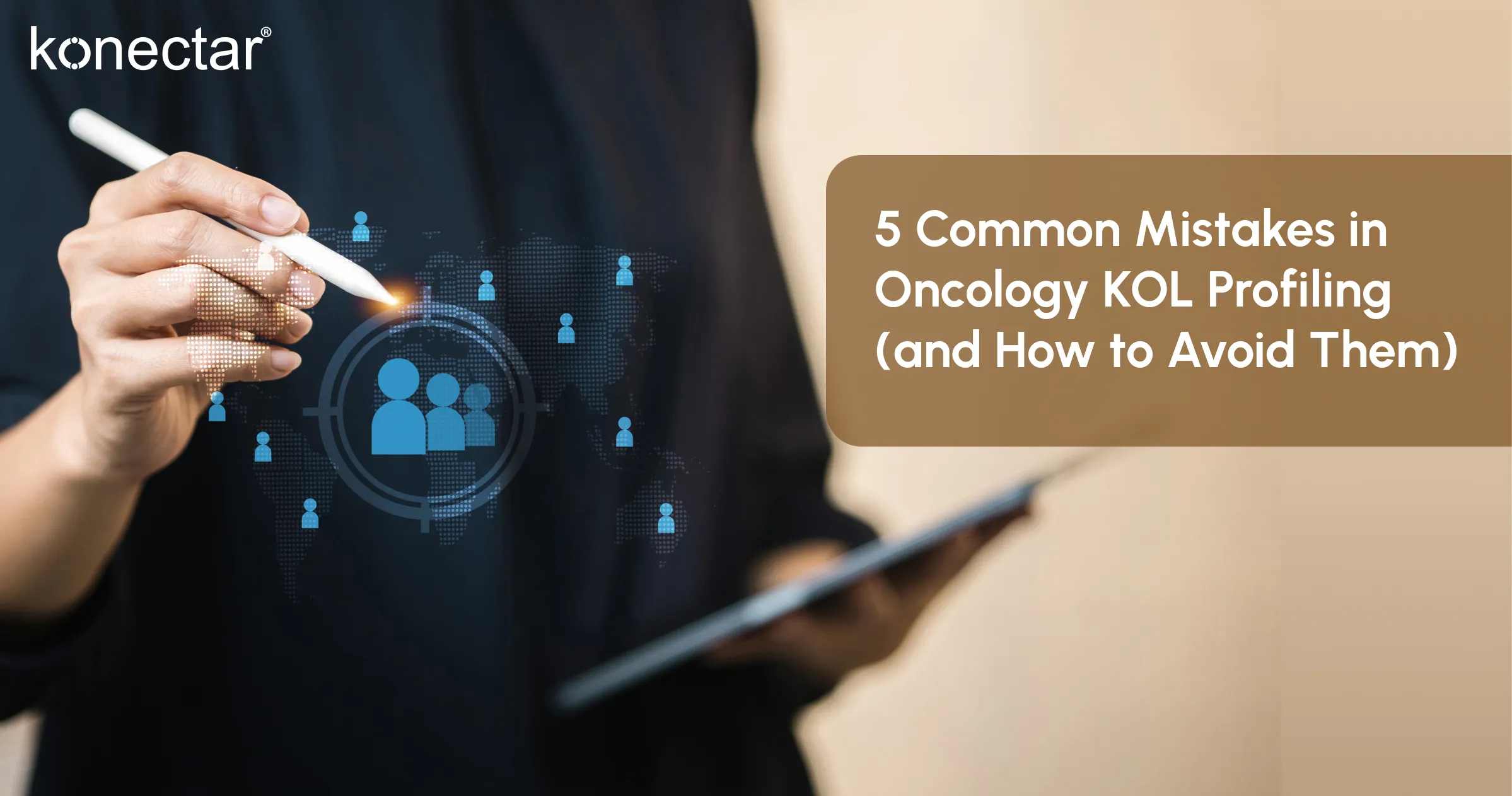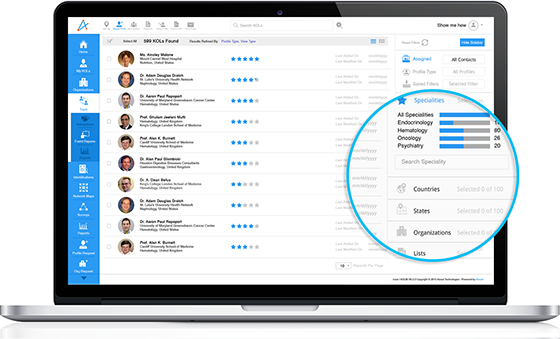29-10-2025
5 Common Mistakes in Oncology KOL Profiling & How to Avoid Them

In oncology, where research advances daily and competition for scientific collaboration is intense, effective oncology KOL profiling can make or break the success of your engagement efforts. It’s a critical step, yet even the most data-savvy teams often stumble in their KOL profiling process. The challenge isn’t a lack of data, it’s knowing what truly matters, how to interpret it, and how to act on it.
Oncology KOL Profiling: What Teams Often Get Wrong
Successful KOL engagement starts with understanding influence from every possible dimension including scientific, clinical, and digital. Many teams still fall into patterns that limit the depth and accuracy of their KOL insights. Below, we explore five common pitfalls in oncology KOL profiling and actionable ways to overcome them.
1. Relying on Single Metrics and Missing Full-Spectrum Influence
Many teams focus on one indication, i.e, publications, clinical trials, or speaking engagements while overlooking the full spectrum of a KOL’s influence. This includes academic and community leaders, trial leadership, society roles, speaking engagements, and digital presence.
Publications are important, but they represent just one dimension of impact. Similarly, ignoring community oncologists or practice-based leaders misses clinicians who shape real-world treatment patterns. Treating any single metric as sufficient gives an incomplete picture of a KOL’s relevance.
How to avoid it:
Adopt a multi-dimensional profiling approach that combines academic, community, and digital influence. Assign appropriate weight to each factor based on strategic objectives to capture a complete and actionable view of each KOL’s impact.
2. Neglecting Emerging KOLs
Many teams focus primarily on established oncology leaders, relying on long-standing reputations. While these experts are influential, emerging KOLs such as researchers leading pivotal trials, chairing new congress sessions, or innovating in emerging therapies can shape the future of oncology practice. Overlooking them risks missed opportunities to engage experts early, before competitors do.
How to avoid it:
Use real-time data and AI-driven insights to track emerging KOLs. Monitor recent publications, trial leadership, conference participation, and early digital influence. Engaging these rising voices early helps your team build strong relationships with the next generation of opinion leaders who may become highly influential in their therapeutic area.
3. Treating KOL Profiles as Static, One-Time Reports
The oncology field is constantly evolving. Researchers can change institutions, shift focus areas, or rise to prominence after a major congress presentation within weeks. Assuming a KOL profile is “complete” risks misaligned outreach and missed opportunities.
How to avoid it:
Implement continuous profiling with automated updates and validation. Track changes in trial leadership, publications, and congress participation on a regular basis to keep KOL lists current and strategically relevant.
4. Ignoring Digital and Social Influence
Scientific credibility is vital, but oncology influence increasingly occurs online—through social media, virtual conferences, and professional forums. Many clinicians actively shape peer and public perception digitally, sometimes faster than traditional journals.
How to avoid it:
Integrate social and digital analytics into KOL profiling. Look beyond follower counts to engagement quality, who interacts, how often, and on which topics. Map digital influence networks to uncover KOLs who can amplify your therapy area effectively.
5. Operating in Silos with Disconnected Systems
When oncology KOL data sits in separate systems, teams often lose the full picture of an expert’s influence. Moreover, recording and tracking KOL interactions on an even different system makes it difficult to align strategies, identify collaboration patterns, and act on insights efficiently.
How to avoid it:
Leverage a unified oncology KOL management platform that comes integrated with CRM to consolidate all data and provide insights on one centralized view. This eliminates constant screen-switching and ensures teams can access comprehensive, real-time insights to drive smarter, faster engagement decisions.
How konectar Enhances Oncology KOL Profiling
The difference between a basic KOL list and a strategic profiling list lies in depth, dynamism, and context. konectar crawls various sources across the web to offer you comprehensive profiles of oncology KOLs so you can plan and execute your strategies efficiently. With konectar, teams can:
- Discover oncology KOLs through AI-driven algorithms which analyze their activities across publications, clinical trials, social activity, congress presence, and more to give you a comprehensive profile of their professional background.
- Map Influence Networks to visualize collaborations across tumor types, institutions, and regions. This allows teams to gain clarity on how scientific relationships shape decision-making and research impact.
- Track Emerging Experts in real time, ensuring teams can spot rising voices early to build long-term, mutually beneficial relationships. This also ensures KOL lists remain relevant and future-focused.
- Engage Strategically with insights that connect scientific focus to influence, enabling meaningful, data-backed interactions. Prioritize outreach with the right experts at the right time for maximum engagement value.
It’s a unified ecosystem that provides not just in-depth HCP profiles but actionable intelligence on various aspects of the healthcare landscape so you know your every action is based on data-driven insights. By combining advanced analytics with intuitive visualization, konectar helps teams move from simply identifying oncology experts to building relationships that advance science and improve patient outcomes.
In a field as dynamic as oncology, influence shifts overnight but with konectar, your understanding of it never falls behind. For more details, request a demo of konectar!
FAQs
- What is oncology KOL profiling, and why is it important?
Oncology KOL profiling is the process of identifying and understanding key opinion leaders in the oncology field such as clinicians, researchers, and digital influencers who shape scientific discussions, clinical practice, and treatment adoption. Effective profiling helps Medical Affairs teams to prioritize engagement, build strategic collaborations, and align outreach with scientific goals.
- How is multi-dimensional profiling different from traditional KOL lists?
Traditional KOL lists often focus on one metric, like publications or trial participation. Multi-dimensional profiling considers publications, trial leadership, speaking engagements, society roles, community influence, and digital presence giving a complete and actionable view of a KOL’s impact.
- Why should emerging KOLs be tracked alongside established leaders?
Emerging KOLs may lead pivotal trials, chair new congress sessions, or drive innovation in therapies. Engaging them early ensures your team builds relationships with future influencers before competitors, keeping your strategies forward-looking and competitive.





